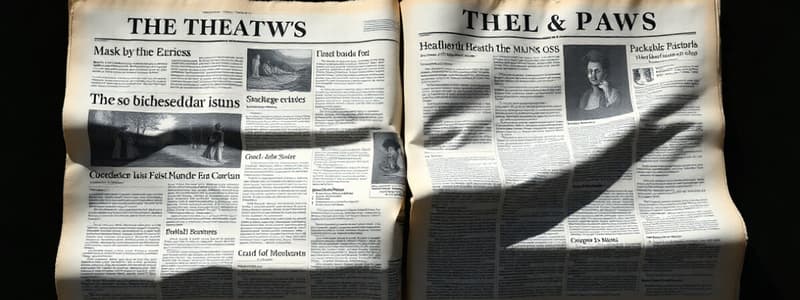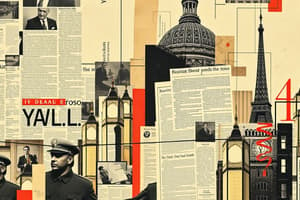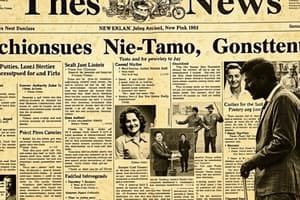Podcast
Questions and Answers
Which section of a newspaper is primarily dedicated to presenting opinions and commentary from editors and invited writers?
Which section of a newspaper is primarily dedicated to presenting opinions and commentary from editors and invited writers?
- Business
- News
- Lifestyle
- Opinion/Editorial (correct)
A real estate company wants to advertise available properties. Which section of the newspaper is most appropriate for this?
A real estate company wants to advertise available properties. Which section of the newspaper is most appropriate for this?
- Business
- Sports
- Classifieds (correct)
- Arts & Culture
In a news article, which element is designed to immediately capture the reader's attention and summarize the article's central point?
In a news article, which element is designed to immediately capture the reader's attention and summarize the article's central point?
- Byline
- Lead
- Headline (correct)
- Body
Why are quotations included in news articles?
Why are quotations included in news articles?
Which design element in newspapers is primarily responsible for enhancing readability and visual appeal through the use of fonts and text styles?
Which design element in newspapers is primarily responsible for enhancing readability and visual appeal through the use of fonts and text styles?
What is the primary goal of using an objective tone in news writing?
What is the primary goal of using an objective tone in news writing?
Which writing style commonly incorporates slang and colloquialisms?
Which writing style commonly incorporates slang and colloquialisms?
What element is most responsible for establishing the mood in a written text?
What element is most responsible for establishing the mood in a written text?
Which of the following is most likely to create a suspenseful mood in a text?
Which of the following is most likely to create a suspenseful mood in a text?
What is the purpose of the masthead in a newspaper?
What is the purpose of the masthead in a newspaper?
Which component of a newspaper answers the questions of Who? What? When? Where? Why? and How?
Which component of a newspaper answers the questions of Who? What? When? Where? Why? and How?
In a newspaper, what is the primary function of captions?
In a newspaper, what is the primary function of captions?
What is the main purpose of opinion/editorial pieces in a newspaper?
What is the main purpose of opinion/editorial pieces in a newspaper?
Which of the following contributes directly to the emotional atmosphere of a text?
Which of the following contributes directly to the emotional atmosphere of a text?
Why is understanding the context important in mood analysis?
Why is understanding the context important in mood analysis?
Which of the following methods involves carefully examining language, imagery, and tone to analyze mood?
Which of the following methods involves carefully examining language, imagery, and tone to analyze mood?
How might short, choppy sentences affect the mood of a text?
How might short, choppy sentences affect the mood of a text?
The use of objects, people, or events to represent abstract ideas or emotions is known as what?
The use of objects, people, or events to represent abstract ideas or emotions is known as what?
Which tool can be used to automate the analysis of the emotional tone in the text?
Which tool can be used to automate the analysis of the emotional tone in the text?
Which of the following sections in a newspaper would most likely contain reviews of new movies and theatrical performances?
Which of the following sections in a newspaper would most likely contain reviews of new movies and theatrical performances?
Flashcards
Headline
Headline
The title of the article, intended to grab attention and summarize the main point.
Byline
Byline
The name of the author or reporter who wrote the article.
Lead
Lead
The opening paragraph of the article, providing the most important information.
Quotations
Quotations
Signup and view all the flashcards
Images/Graphics
Images/Graphics
Signup and view all the flashcards
Layout
Layout
Signup and view all the flashcards
Typography
Typography
Signup and view all the flashcards
Captions
Captions
Signup and view all the flashcards
White Space
White Space
Signup and view all the flashcards
Objective Tone
Objective Tone
Signup and view all the flashcards
Subjective Tone
Subjective Tone
Signup and view all the flashcards
Formal Tone
Formal Tone
Signup and view all the flashcards
Informal Tone
Informal Tone
Signup and view all the flashcards
Positive Mood
Positive Mood
Signup and view all the flashcards
Negative Mood
Negative Mood
Signup and view all the flashcards
Neutral Mood
Neutral Mood
Signup and view all the flashcards
Masthead
Masthead
Signup and view all the flashcards
Opinion/Editorial Pieces
Opinion/Editorial Pieces
Signup and view all the flashcards
Close Reading
Close Reading
Signup and view all the flashcards
Emotional Word Count
Emotional Word Count
Signup and view all the flashcards
Study Notes
- Newspapers are a vital part of the media landscape, offering information and analysis on current events
- Newspapers have a specific structure, tone, and mood, all contributing to how information is conveyed
Structure of a Newspaper
- Newspapers are organized to present information in a clear and accessible way
- Newspapers typically follow a structure that includes different sections, articles, and design elements
Sections
- News covers current events, both local and international
- Opinion/Editorial presents viewpoints and commentary from editors and columnists
- Business reports on economic and corporate news
- Sports covers sports events, athletes, and teams
- Arts & Culture includes reviews, features, and articles related to art, music, theater, and literature
- Lifestyle focuses on topics such as fashion, food, home decor, and health
- Classifieds are advertisements for jobs, real estate, and other services
Articles
- Headline is the title of the article, designed to grab the reader's attention and summarize the main point
- Byline is the name of the author or reporter who wrote the article
- Lead is the opening paragraph of the article, which provides the most important information (who, what, when, where, why, and how)
- Body is the main part of the article, providing details, background information, and supporting evidence
- Quotations are statements from people related to the story, adding credibility and different perspectives
- Images/Graphics are visual elements that illustrate the story and break up the text
Design Elements
- Layout is the arrangement of articles, images, and advertisements on the page.
- Typography is the use of fonts and text styles to enhance readability and visual appeal
- Captions are brief descriptions accompanying images or graphics
- White Space refers to empty areas on the page that improve readability
Tone in Text
- Tone refers to the attitude of the writer toward the subject or audience
- In news writing, an objective and neutral tone is generally preferred
- Tone is conveyed through word choice, sentence structure, and the selection of information
Objective Tone
- Presents facts without personal feelings, opinions, or biases
- Uses neutral language and avoids emotional words or phrases
- Relies on evidence and verifiable information
Subjective Tone
- Includes personal feelings, opinions, or biases
- Uses emotional language and may include persuasive elements
- More common in opinion pieces, editorials, and columns
Formal Tone
- Uses sophisticated language and avoids slang or colloquialisms
- Adheres to grammatical rules and conventions
- Common in news articles and official reports
Informal Tone
- Uses casual language and may include slang or colloquialisms
- More conversational and relaxed
- Common in blogs, personal essays, and some feature articles
Mood in Text
- Mood is the overall feeling or atmosphere created in a text, influencing the reader's emotional state
- Mood is established through descriptive language, imagery, and setting
Positive Mood
- Creates feelings of happiness, optimism, and hope
- Uses cheerful, uplifting language
- Often found in stories with happy endings or positive themes
Negative Mood
- Creates feelings of sadness, fear, or anger
- Uses dark, somber language
- Often found in stories about tragedy, conflict, or loss
Neutral Mood
- Creates a sense of objectivity and detachment
- Uses factual, unemotional language
- Common in news reports aiming for impartiality
Suspenseful Mood
- Creates feelings of tension, anticipation, and uncertainty
- Uses foreshadowing, mystery, and dramatic language
- Commonly found in thrillers, mysteries, and suspenseful news stories
Components of a Newspaper
- A newspaper consists of various components that work together to deliver news and information to its readers
Masthead
- The title of the newspaper is usually displayed prominently on the front page
- Includes the newspaper's name, logo, and sometimes its motto or founding date
Headlines
- Titles of articles summarize the main topic and grab the reader's attention
- Vary in size and style to reflect the importance of the story
Byline
- The name of the reporter or writer authored the article
- Indicates who is responsible for the content
Lead
- The opening paragraph of the article contains the most important information
- Answers the questions: Who? What? When? Where? Why? and How?
Body
- The main part of the article provides details, background information, and supporting evidence
- Organized into paragraphs and sections for clarity
Quotations
- Direct statements from people related to the story
- Add credibility, perspective, and human interest
Captions
- Brief descriptions accompany photographs, illustrations, or graphics
- Provide context and additional information
Images/Graphics
- Visual elements that illustrate the story and break up the text
- Include photographs, illustrations, charts, and maps
Advertisements
- Paid announcements from businesses and organizations
- Provide revenue for the newspaper
Classifieds
- Small advertisements are often for jobs, real estate, and services
- Usually organized by category
Opinion/Editorial Pieces
- Express the opinions of the newspaper's editors or invited columnists
- Aim to provide analysis, commentary, and different points of view
Mood Analysis in Texts
- Mood analysis involves identifying and understanding the emotional atmosphere created in a text
- It helps readers interpret the writer's intent and the potential impact on the audience
- Several factors contribute to the overall mood of a text
Word Choice
- Specific words and phrases can evoke certain emotions
- Positive words (e.g., joy, hope, love) create a positive mood
- Negative words (e.g., sorrow, fear, hate) create a negative mood
Imagery
- The use of descriptive language to create vivid mental images
- Imagery can evoke feelings of tranquility, excitement, or dread
Setting
- The time and place in which a story occurs
- The setting can contribute to the mood by creating a sense of comfort, adventure, or unease
Tone
- The writer's attitude toward the subject or audience
- A serious tone can create a somber mood, while a humorous tone can create a lighthearted mood
Sentence Structure
- Short, choppy sentences can create a sense of urgency or tension
- Long, flowing sentences can create a sense of calm or reflection
Symbolism
- The use of objects, people, or events to represent abstract ideas or emotions
- Symbols can add depth and complexity to the mood of a text
Context
- The social, cultural, and historical background of the text
- Understanding the context can help readers interpret the mood accurately
Methods for Mood Analysis
- Close Reading involves analyzing the text carefully, paying attention to language, imagery, and tone
- Emotional Word Count involves identifying and counting words associated with specific emotions
- Sentiment Analysis Tools involve using software to automatically analyze the emotional tone of a text
Studying That Suits You
Use AI to generate personalized quizzes and flashcards to suit your learning preferences.




